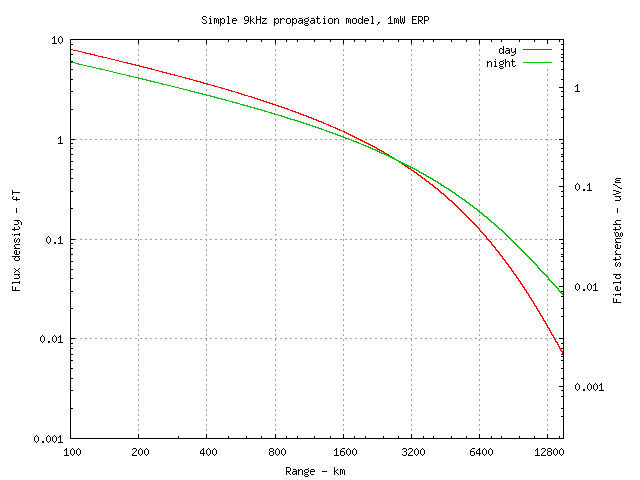A few years ago the Bundesnetzagentur indicated that German radio amateurs were 'free' to make transmissions below 9kHz. Recently one or two stations have taken up the challenge of broadcasting enough ERP to be detectable well into the far field.
These notes report the reception at Todmorden, UK, 53.703N 2.072W.
The signal appeared faintly in a 0.005Hz/200 second spectrogram between 14:30 and 16:00 UT. The amplitude spectrum averaged over the 90 minutes is shown below.

The transmission was detected in the H-field at Todmorden with a significance of about 7 sigma. Allowing for signal spread due to modulation and drift, and the breaks in transmission, the average flux density was probably 2.0 to 3.0fT. This agrees with a model in which the signal power is trapped in the Earth-ionosphere cavity with an attenuation of about 3dB/1000km. A more detailed reception report is here.
Slight increase in ERP since the previous test. Reception conditions were unfavourable for the first part of the test due to the background noise averaging to the same bearing as Frankfurt. Below is the flux density averaged over a single 10 minute 'dot' of the DFCW600.

Average flux density was about 2.7fT +/-50%, average bearing was 116.9 deg. The peak is 9.6 sigma from the mean noise of 0.7 fT.
Several other receivers picked up the signal and some were able to read the DFCW600 and QRSS120 Morse letters. A summary of reception reports is here.
A simple propagation model for VLF assumes the radiated signal is trapped between the two spherical shells of the Earth-Ionosphere cavity, thus giving approximately a 1/sqrt(r) field strength dependence on range r. Combining with an exponential decay factor to allow for average losses, we have [1],
B = 1.0e-6 * sqrt(ERP * 5.23e-6/sin(r/6371e3)) * exp(-r/a)/h; E = 300 * sqrt(ERP * 5.23e-6/sin(r/6371e3)) * exp(-r/a)/h; where B = flux density, tesla; E = field strength, volts/metre; r = great circle range, metres; a = attenuation factor, 2.9e6 for daytime, 4.3e6 for night; ERP = effective radiated power, watts; h = D-region height, metres, 70e3 day, 95e3 night;

At shorter ranges, daytime signals are higher due to the lower ionosphere height. At longer range, the lower attenuation produces better signal strength at night. With the estimates for daytime and nighttime attenuation of 3dB/Mm and 2dB/Mm respectively, the crossover occurs at 2700km.
Defects of this model:
[1] James R Wait
'A study of VLF field strength data both old and new'
Pure and applied geophysics, vol 41 sept 1958 pp73-85.